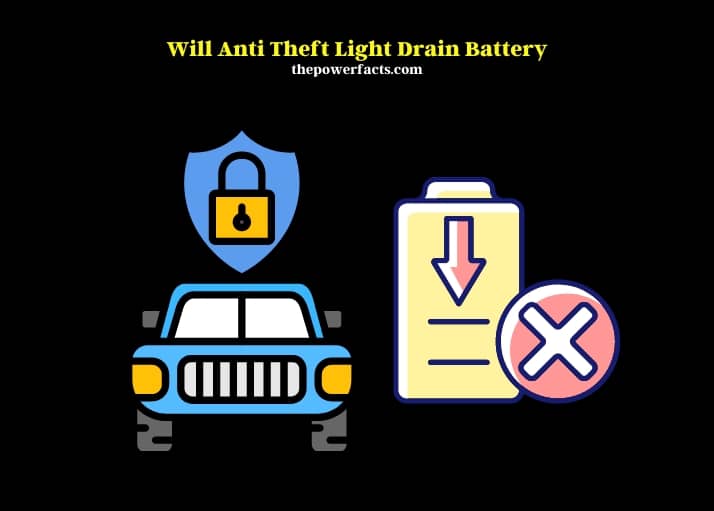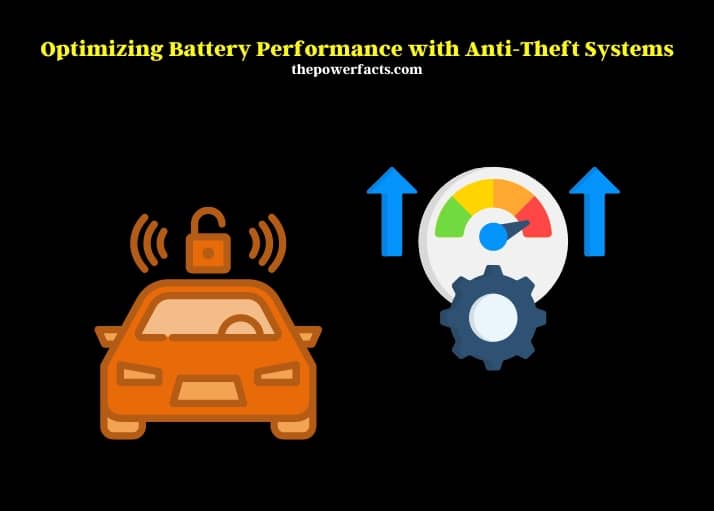An anti-theft light, while active, does draw a minimal amount of power from a car’s battery. However, this drain is usually insignificant and should not cause a healthy battery to deplete when the car is used regularly.
The role of an anti-theft light in a vehicle’s security system is primarily as a deterrent. Its presence signals to potential thieves that the vehicle is protected, thereby reducing the likelihood of theft. These lights are designed to be energy-efficient, ensuring their continuous operation does not significantly impact the vehicle’s battery life.
In typical scenarios, the car’s alternator replenishes the battery, offsetting the small amount of power used by the anti-theft light and other electronics.

However, in situations where a vehicle is left idle for extended periods, the cumulative effect of various small power drains, including the anti-theft light, can become more apparent. In these cases, the battery might gradually lose charge, potentially leading to starting issues.
To prevent this, car owners are advised to start their vehicles periodically or use a battery maintainer. Additionally, regular battery maintenance, such as checking charge levels and ensuring clean and tight connections, can help prolong battery life and prevent issues related to power drain from the anti-theft light and other electrical components.
Battery Longevity and Anti-Theft Light Impact
The concern about whether anti-theft lights drain car batteries is valid, given the essential role of a vehicle’s battery in its overall functionality. A car battery, typically designed to last 3-5 years, can experience varying degrees of strain from different electrical systems, including anti-theft lights.
These lights, while consuming power, do not significantly drain the battery compared to more demanding components like the starter motor or headlights. However, the cumulative effect over time, especially in vehicles that are not regularly used, can be noticeable.
To mitigate this drain, it’s crucial to understand the rate at which these systems consume power. For instance, a standard anti-theft light might draw around 20-50 milliamps. In comparison, headlights can draw up to 15 amps.
Regular maintenance and mindful usage of electrical components can help extend battery life. Strategies like regular battery checks, ensuring the lights are off when the car is not in use, and using a battery maintainer for vehicles left idle for extended periods can be effective.
Anti-Theft Lights in Vehicle Security
Anti-theft lights serve as a visual deterrent to potential thieves, signaling that a vehicle is equipped with a security system. Their effectiveness, while not as quantifiable as more advanced security measures like GPS trackers or immobilizers, plays a significant role in vehicle security. The psychological impact on thieves, who are often looking for the easiest target, is substantial.
Case studies in vehicle theft prevention show that cars with visible anti-theft indicators, including blinking lights, are less likely to be targeted. However, it’s crucial to balance these measures with other security systems for comprehensive protection. Advancements in anti-theft technology have led to more sophisticated systems, which integrate seamlessly with vehicle electronics, offering enhanced security without significantly impacting battery life.
Anti-Theft Systems vs. Battery Health
The interaction between anti-theft systems and vehicle battery health is a nuanced one. While these systems are designed to be minimally invasive in terms of power consumption, their continuous operation, especially in older vehicles, can contribute to battery wear. Signs of battery wear include slower engine cranking and dimming lights.
Maintaining battery health involves regular check-ups and understanding the specific needs of your vehicle’s battery. For example, a standard lead-acid battery requires different care compared to an AGM (Absorbent Glass Mat) battery. Experts recommend routine inspections and ensuring the battery is adequately charged, especially in colder climates where battery performance can be significantly impacted.
To illustrate the relationship between anti-theft systems and battery health, consider the following data table:
| Battery Type | Average Lifespan | Impact of Anti-Theft System |
| Standard Lead-Acid | 3-5 years | Moderate |
| AGM Battery | 5-7 years | Low |
| Lithium-Ion | 8-10 years | Minimal |
This table highlights that while anti-theft systems have some impact, the type of battery plays a more significant role in overall health and longevity.
Cost-Benefit Analysis of Vehicle Anti-Theft Lights
When evaluating the cost implications of running anti-theft systems, it’s essential to weigh the security benefits against the potential for increased battery wear and the associated replacement costs. The economic impact of vehicle theft is substantial, making the investment in security systems, including anti-theft lights, justifiable.
The cost of battery replacement should also be considered. The following table compares the costs associated with different anti-theft systems and the potential savings in terms of theft prevention:
| Anti-Theft System | Initial Cost | Estimated Cost Savings (Theft Prevention) |
| Basic Alarm System | $100 – $200 | $1,000 – $3,000 |
| Advanced Alarm System with GPS | $500 – $1,000 | $4,000 – $10,000 |
| Immobilizer System | $150 – $300 | $2,000 – $5,000 |
This data suggests that while there are upfront costs, the long-term savings and peace of mind offered by these systems can be significant.
Optimizing Battery Performance with Anti-Theft Systems
Innovative solutions are emerging to balance the need for effective anti-theft systems with the desire to optimize battery performance. Advances in technology have led to more energy-efficient anti-theft solutions that minimize battery drain. For instance, newer systems are designed to enter a low-power mode when the vehicle is inactive, significantly reducing their energy consumption.

Breakthroughs in battery technology also contribute to this balance. Modern batteries are more resilient and capable of handling the demands of advanced security systems without compromising their lifespan. The integration of smart technology in vehicles allows for real-time monitoring of battery health, ensuring that any potential issues are addressed promptly.
Case studies in new vehicle models demonstrate successful integrations of these technologies, offering enhanced security without sacrificing battery performance. As these technologies evolve, we can expect even more efficient and effective solutions in vehicle security and battery management.
FAQs
Can Leaving a Car Idle Affect the Anti-Theft Light’s Battery Drain?
Leaving a car idle for extended periods can influence the battery drain caused by the anti-theft light. While these lights consume minimal power, their continuous operation in a stationary vehicle can accumulate over time. In a typical scenario, a car battery can sustain this minimal drain without significant impact.
In vehicles that remain unused for weeks or months, even small drains like the anti-theft light can contribute to battery depletion. It’s advisable for car owners to start their vehicles periodically or use a battery maintainer to keep the battery charged during prolonged periods of inactivity.
Is the Anti-Theft Light’s Battery Drain Noticeable in Daily Use?
In daily use, the battery drain from an anti-theft light is generally negligible. These systems are designed to be low-power, ensuring they don’t significantly deplete the battery during normal vehicle operation. For most drivers who use their car regularly, the alternator replenishes any power used by the anti-theft light, along with other electrical systems.
It’s only in situations where the car is left unused for extended periods that the cumulative effect of this drain might become noticeable, potentially leading to a weakened or dead battery.
Can Anti-Theft Lights Drain Battery Like Dollhouse Lights?
Yes, anti-theft lights can drain the battery just like dollhouse lights. However, it’s important to note that the impact on the dollhouse lights lifespan could be minimal if the battery is kept charged and in good condition. Regular maintenance is crucial to ensure longevity.
Do Weather Conditions Influence the Anti-Theft Light’s Battery Drain?
Weather conditions can indirectly affect the battery drain caused by an anti-theft light. Extreme temperatures, both hot and cold, can impact a car battery’s overall performance and efficiency. In cold weather, batteries tend to lose their charge more quickly and may struggle to power even low-drain systems like anti-theft lights effectively.
Conversely, in hot weather, battery fluid can evaporate, leading to decreased battery life. While the anti-theft light itself doesn’t drain more power in different weather conditions, its impact can be more pronounced if the battery is already weakened by temperature extremes.
Can Upgrading the Battery Reduce the Impact of Anti-Theft Light Drain?
Upgrading to a higher-quality or more suitable battery can mitigate the impact of the anti-theft light’s drain. Modern batteries, such as AGM or lithium-ion types, offer better performance and longer lifespans compared to traditional lead-acid batteries. These advanced batteries are more efficient in handling small, continuous drains like those from anti-theft systems.
They are particularly beneficial for vehicles with multiple electronic accessories or for those left idle for extended periods. Choosing the right battery type for your vehicle and usage pattern can significantly reduce concerns about battery drain from anti-theft lights.
How Do Different Anti-Theft Light Systems Vary in Power Consumption?
Anti-theft light systems can vary in their power consumption based on their design and functionality. Basic indicator lights, which simply blink to show the system is active, consume very little power. More sophisticated systems, which might include additional features like motion sensors or connectivity to a central alarm system, could have a slightly higher power draw.
Even these advanced systems are generally designed to be energy-efficient. The difference in power consumption between basic and advanced anti-theft lights is typically minimal and should not be a major concern for battery drain in most vehicles.
What Maintenance Tips Can Prolong Battery Life with an Anti-Theft Light?
Regular maintenance can help prolong battery life in a vehicle equipped with an anti-theft light. Key tips include routinely checking the battery’s charge level and ensuring it’s kept fully charged, especially during cold weather. Keeping the battery terminals clean and free from corrosion is also crucial for optimal performance. For vehicles that are not used regularly, using a battery maintainer or disconnecting the battery can prevent gradual drain.
Having the electrical system, including the anti-theft light, checked by a professional during regular vehicle servicing can ensure everything is functioning efficiently, minimizing unnecessary battery strain.
Summary
The relationship between anti-theft lights and car battery longevity is a balance of security and efficiency. While these systems do consume power, their impact on battery life is relatively minimal, especially when compared to other vehicle components. Regular maintenance and the use of advanced, energy-efficient systems can help mitigate any potential drain.
The cost-benefit analysis favors the use of anti-theft systems, considering the high cost of vehicle theft. Innovations in both anti-theft and battery technologies are continually improving this balance, ensuring vehicles remain secure without compromising battery health.